Bulk Pricing
4 Port USB 3.2 Gen 1 Mini Powered Hub w/ ESD Surge Protection & Power Adapter
Industrial Grade | +5V DC Input | Surge Protection | Surface Mountable | 5 Gbps
- Protect Your Equipment: The 4-port hub features 15kV ESD surge protection to keep your connected peripherals safe from harm.
- Super Fast Speeds: This USB hub is 3.2 Gen 1 compliant, ensuring super-fast 5Gbps data transfer speeds. It supports super speed, high speed and full speed which enables it to be compatible with USB 2.0 / 1.1.
- Small-Scale Quality: Housed in a compact steel chassis, the 4-port hub is perfect for discreet installations in offices, labs, warehouses, heavy machinery, automation equipment, and other industrial applications.
- Upstream: 1 USB port, Type B connector
- Downstream: 4 USB ports, Type A connectors
- Power Connector: DC Barrel 2.5mm ID × 5.5mm OD, Center Pin Positive
- Mounting Options: Wall & Surface
Description

Introduction:
USB 3.2 Gen 1 powered hub with industrial-grade chassis and surface mounting flanges. The CG-U3MINI4PH is a 5V DC input, generation 1 USB 3.2 Gen 1 hub with ESD and Surge protection. This USB 3.1 Hub will support fast charging for Apple and Samsung Galaxy devices. Each port is protected individually to help keep your peripherals safe. The USB 3.2 Gen 1 Hub uses a GL 3510 chip, each port is on an individual circuit to maintain high current and protection. The GL3510 Hub controller chip features native fast-charging and complies with USB-IF battery charging specification rev1.2.
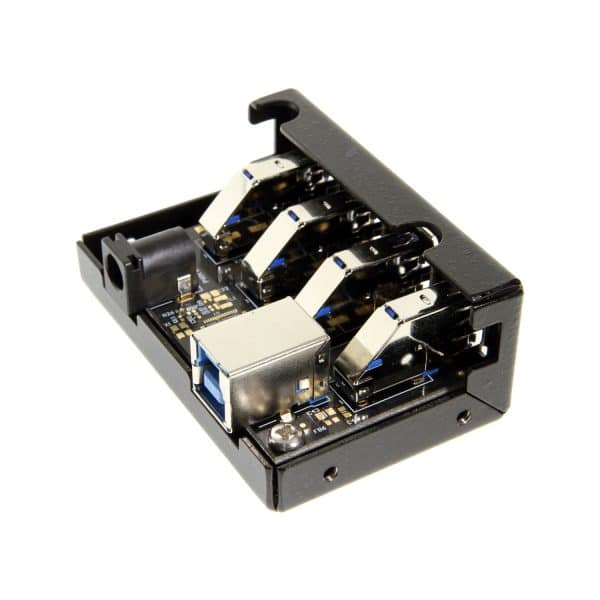
Features:
- Compliant with USB 3.2 Gen 1 Specification
- Upstream port supports Super-Speed (SS), High-Speed (HS) and Full-Speed (FS) traffic
- Downstream ports support SS, HS, FS, and Low-Speed (LS) traffic
- 1 control pipe and 1 interrupt pipe
- Backward compatible to USB specification Revision 2.0/1.1
- Compliant with USB Battery Charging Revision v1.2, supporting CDP, DCP, and ACA-Dock
- Downstream ports can be turned from a Standard Downstream Port (SDP) into Charging Downstream Port (CDP) or Dedicated Charging Port (DCP)
- Downstream devices can be charged while upstream VBUS is not present, which can be applied on wall charger applications
- Upstream port is capable of charging and data communicating simultaneously for portable devices supporting ACA-Dock or proprietary charging protocols
- Compatible with Windows 7, 8, 10, 11, Linux & Mac OSX
Specifications:
- Chip: GL3510
- USB 3.2 Gen 1 Gen Compliant
- Supports High Speed and Full Speed transmit and Receive
- Complies with USB-IF battery charging specification rev1.2
- Automatic switching between self-powered and bus-powered modes
- Built-in 5 to 3.3V and 5 to 1.2V regulator
- RISC-like architecture
- Item Dimensions: 2.86″(L 3.8″ w/ears) x 1.85(W) x 1.16(H)
- Item Weight: .32 lbs. (5.2 oz)
Package Contents:
- USB 3.2 Gen 1 4-Port Hub
- 4 Amp 5V DC Mini-Switching Power Adapter
- Don’t need a Power Adapter? Bus-powered version available: CG-U3MINI4P-BPH
- 3ft. USB A to B Cable for Hub
*Surface Mounting screws not included.
Related Products
Related Products
Model# CG-U3MICRO4PH
$114.74In stock
Model# CG-U3MINI4PH-G2
$82.49Not in stock - Backorder allowed
Model# CG-U3CMicro4ph-G2
$104.49Out of stock
Model# CG-U3CAMICRO4PH
$121.49Not in stock - Backorder allowed
Specifications
Product Specifications
| Power |
| ||||||||||||
|---|---|---|---|---|---|---|---|---|---|---|---|---|---|
| Compliance |
| ||||||||||||
| Physical Characteristics |
| ||||||||||||
| What's in the Box |
| ||||||||||||
| Software |
| ||||||||||||
| Environmental |
| ||||||||||||
| Product Information |
| ||||||||||||
| Hardware |
| ||||||||||||
| Performance & Safety |
| ||||||||||||
| Other Data |
|
Support
Product Documentation & Drivers
Product Documents
Need drawings, CAD files, or other compliance documentation? Click HERE
Relevant Articles & F.A.Q.
Relevant Articles
Product F.A.Q.
View frequently asked product questions below. Still need help? Reach out!
-
Can the hub be used without a power supply?
View AnswerIn some cases, yes. USB peripherals that only require low power (i.e. keyboards & mice) can be used without a power adapter. Power in this case is drawn from the host’s USB port.
When high-power USB peripherals are used, a power supply for the USB hub may be required. In other cases, the USB peripheral may require their own power adapters, in this case, a power supply for the hub may not be required. Without ample power though, the USB hub or connected peripherals may not operate correctly. It is recommended to use an included power supply when possible.
-
After waking up from sleep mode, my computer/host no longer recognizes my USB device.
View AnswerIf the USB device does not function properly after your computer or host has been in sleep mode, it is likely that Windows turned off the USB Root hub in order to save power.
To prevent this, follow the steps below (depending on your operating system).
Windows 10 / 8
- On your keyboard, press the Windows key + X and select Control Panel.
- Click Hardware and Sound, then click Power Options.
- Click Change plan settings for the plan you want to change.
- Click Change advanced power settings.
- Click the plus sign (+) next to “USB settings” and “USB selective suspend setting” to expand the options and change the setting to Disabled.
- Click OK to apply the setting.
Note: You may need to disconnect and re-connect your USB device after applying these settings.
Windows 7 / Vista
- Click the Start button and select Control Panel.
- Click Hardware and Sound, then click Power Options.
- Click Change plan settings for the plan you want to change.
- Click Change advanced power settings.
- Click the plus sign (+) next to “USB settings” and “USB selective suspend setting” to expand the options and change the setting to Disabled.
- Click OK to apply the setting.
Note: You may need to disconnect and re-connect your USB device after applying these settings.
Windows XP
- On your desktop, right-click the My Computer icon and select Properties.
- Click the Device Manager tab.
- Expand Universal Serial Bus controllers by clicking the arrow to the left of it.
- Right-click the first USB Root Hub device and select Properties.
- Click the Power Management tab.
- Clear the box next to Allow the computer to turn off this device to save power.
- Click OK to apply the setting.
- Repeat steps 4-7 for any remaining devices in the Universal Serial Bus Controllers section with “Root Hub” in the name.
Note: You may need to disconnect and re-connect your USB device after applying these settings.
-
The hub is properly hooked up, but is not functioning correctly. What can I do?
View AnswerTesting all setup components is the best place to begin troubleshooting. To determine the source of the issue, individually test your:
- USB Cable by using it in another setup, or trying another cable.
- Host USB Port by connecting another device or thumb drive.
- Connected Peripherals by connecting directly to the host.
Moving on to troubleshooting the hub itself. Attach a USB peripheral. The USB hub itself will not appear in hardware listings on your host’s system. USB devices connected however, will appear when connected. If the connected device is still not being found, try:
- Installing the required drivers for the USB peripheral.
- Install the most recent drivers for the USB controller and/or motherboard chipset.
USB hubs do not require drivers or software.
Troubleshooting the desired USB peripheral may be in order. If the peripheral is still not being recognized, attempt:
- Attaching external power to the peripheral, if required.
- Confirming if the peripheral functions on a standard USB port.
- Testing if basic USB peripherals work, such as keyboards or mice.
-
How can external power be connected to the industrial USB hub?
External power is supplied by connecting to the terminal block located on the hub. For when an external power adapter is required check out the Accessories & Replacement Parts section on this product page. To view all of our hub accessories and power supplies, visit the category here.
How to properly choose a power supply.To determine the power requirements, the equation to use is P = 5 * I * N, where:
P is the power wattage.
5 is the USB port voltage.
I is the current of the USB port in Amps (USB 2.0 is 0.5A, USB 3.0 is 0.9A.
N is the number of USB ports.
As an example using the equation, a 4 port hub would reflect a minimum wattage of 18 watts.
Knowing the minimum requirement, a proper power adapter can be chosen. In this case the voltage of a power supply should be within 7 to 24 or 7 to 40 Volts DC, depending on the specifications of the USB hub. Also, the power supply must convert AC to DC (no AC output).
Power supplies often come with a voltage (V) rating and an amperage (A) rating. To determine the current in amps, use I = P / V, where the following is true:
I is the current of the power supply.
P is the calculated power of the hub.
V is the chosen voltage of the power supply
Continuing the example, the 4 port hub requires 18 W and the power supply you choose is 12V, the current of the power supply would be I = 18/12, I = 1.5A.
Our full collection of power adapters can be found here.











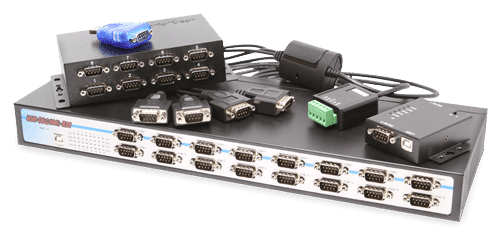
















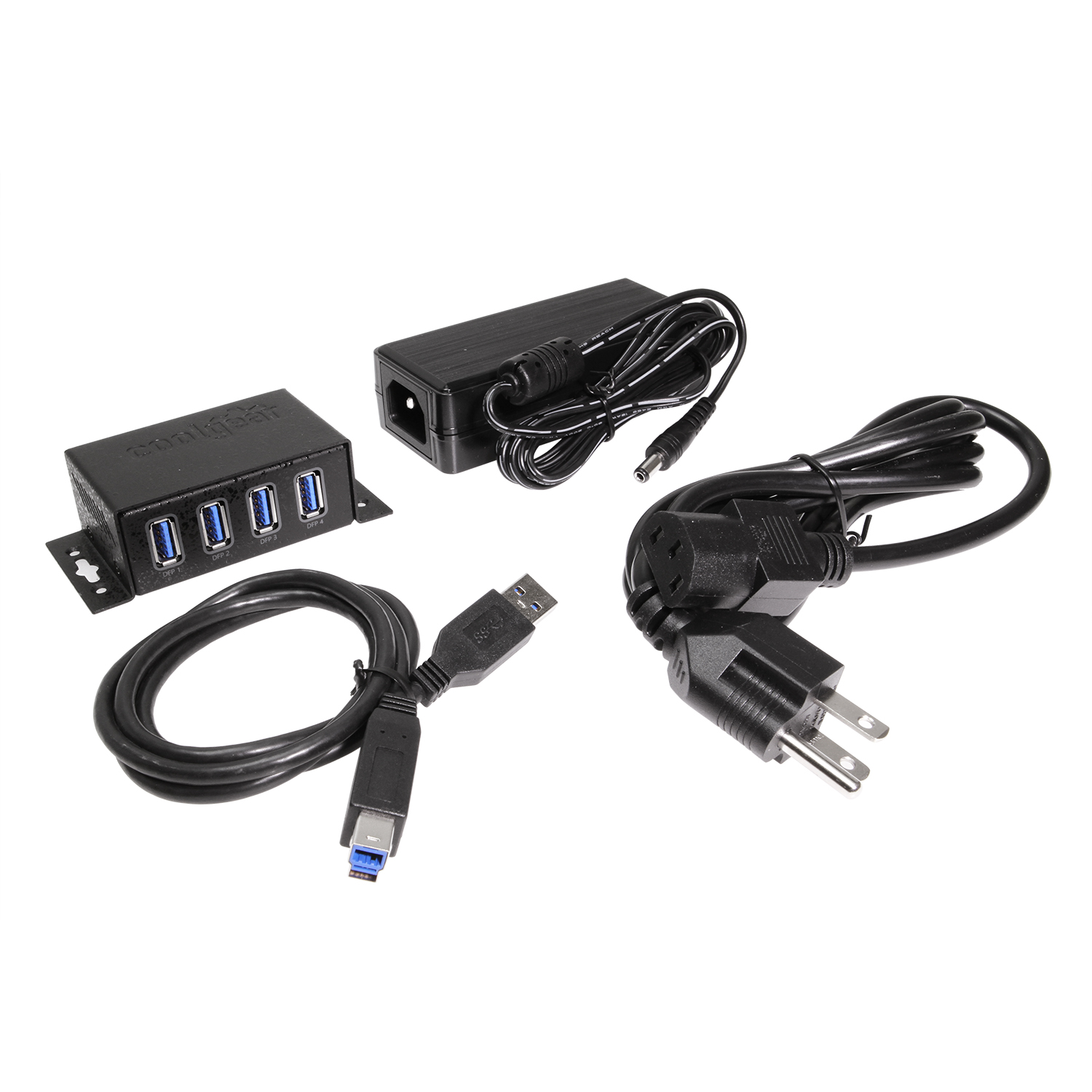
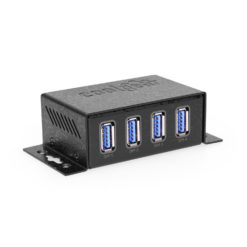












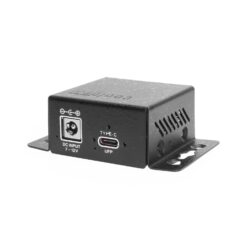










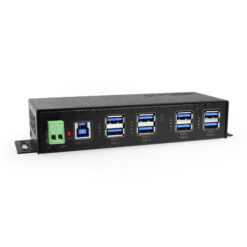








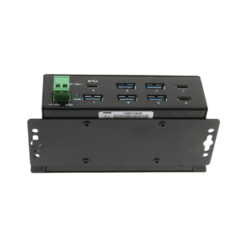

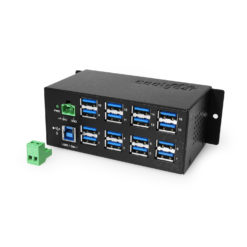
Marty –
5.0 out of 5 stars
very reliable
solid connection no noticeable input delay and provides ample power. i have stream deck, mouse charger, and camera connected no problems with stream deck and camera running at same time. would recommend. love the finish on it and easy to mount.
Thomas K. –
3.0 out of 5 stars
Power cable loose
Had to return because the power cable was too loose and the hub would lose power. Disappointing because the build quality was good, and this unit was recognized at USB 3 by the system, which is what we were looking for.
Jeffrey Spears –
5.0 out of 5 stars
Well built. Reliable data transfer.
Bought a cheap power USB hub a while back. I play with raspberry pi’s and need to write reliably to SD cards. The cheap hub could never write operating systems to the SD cards. Ended up just throwing it away in disgust.This power hub writes operating systems first time every time.It seems well built and very pleased with it. Worth the money.
Rick P. –
5.0 out of 5 stars
Fantastic for power-hungry devices!
Like Ringoo, I also have a simulator that’s used for iRacing, and very high-end wheel with a large display, tons of LEDs, and backlit buttons.(GSI Hyper P1 wheel.)The software for the wheel warns you against using Medium or High brightness for the LEDs and Buttons.Even set to Low brightness in the drivers and then lowered quite a bit more via Simhub (the app that drives all the lights and dashboard while racing) it was having random disconnects on various other powered hubs, or when directly connected to my Asus z790 Hero Motherboard due to requiring about 10 – 15’ of cable to reach the PC from my simulator.I bought this hub after seeing it recommended in the wheel manufacturers Discord site.I connected this hub directly to my PC motherboard via a Cable Matters 10’ USB-B to USB-A USB 3.0 cable instead of the 3’ included cable, and then mounted the hub to my simulator. My wheel connects to one of the four USB ports on it.With this hub, and ONLY this hub I am able to turn all the lights, displays and LEDs up so bright they will sear your eyeballs, & with zero USB drop out.This is AFTER trying 4 other powered USB 3.0 hubs, a powered USB-C hub, and multiple tries with different length USB-A to Female USB-A 3.0 extension cables, with and without a power cord connection or repeater, to connect the wheel to my motherboard without a hub (to USB 3.2 10gb’s ports or 3.0 ports.) No other solution worked, but this hub nails it.5/5 Stars. Now to buy two more of the 7 port version!
Ringooooooooo –
5.0 out of 5 stars
Fantastic USB 3 Hub
I had a particular wheelrim for my sim rig that was very power and data throughput hungry. This hub not only delivers enough power to the wheelrim, not only deals with the data throughput issues, but is built in a very solid metal housing and is very easy to mount to a profile rig.Nothing bad to say about this product; it’s fantastic.